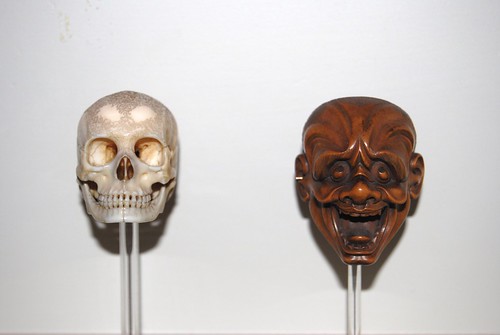Netsuke are miniature Japanese sculptures which are most often carved from ivory or wood, and sometimes from other materials. They were first made in the early 17th century, and used to fasten a small box (the inro) containing medicines and personal belongings to the sash (or obi) worn around traditional Japanese garments such as the kimono. Later on they were made solely for ornamental purposes.
The ivory skull and wooden mask netsuke shown in the photograph above are on display at the Victoria and Albert Museum in London, which has a very nice collection of these delightful objects. Despite being just 1.5 inches in height, they are exquisitely detailed. The skull, for example, is anatomically accurate, with the mandible, maxilla, and frontal, nasal and zygomatic bones depicted correctly.
See more of my netsuke photographs on Flickr, and see also these wonderful vintage Japanese neuroanatomical illustrations.

I love these, Mo. What a perfect Halloween post.
I recently came across this New Yorker article on psychopaths. The article itself is fascinating and is very insightful about the impact of neuroscience on cultural perceptions. However, what interests me the most about psychopaths is this idea that keeps occurring to me and I wanted your opinion.
I wonder if the kind of empathy modern humans have may be a fairly recent mutation, maybe even as recent as ancient Greece. When one reads about the ancient world and the truly horrific practices of torture, slavery and other barbarisms, it's hard not to classify the people behaving this way as psychopaths. Now, of course, some of the modification of human empathy is cultural but still I wonder if there wasn't a fundamental physical change between us and the peoples of the ancient world. What do you think, Mo? Does my idea have any merit by today's knowledge of the brain and genetics?
As far as I know, anatomically modern humans emerged more than 100,000 years ago, and we have not changed since then. However, art, religion and various other aspects of culture are thought to have arisen just ~15,000 years ago, at around which time evidence suggests some regions of the human genome begin to display directional selection.
The long period of time between the emergence of modern humans and the emergence of human culture is, I believe, a subject of debate. But the consensus is that our species is exactly the same as it was in ancient times, and that empathy and morality are traits that emerged in our primate ancestors.
Having said that, I am by no means an expert on human evolution, so let me recommend someone who is: John Hawks. See also the Neuroanthropology blog for more on the evolution of culture.
Thanks for answering this one, Mo. I realized after I'd asked the question how impossible it is to answer since I was kind of fuzzy and blurred the line between empathy and sympathy. Of course our early human ancestors had empathy since the lower primates have mirror neurons. I suppose the modification is cultural and the sad thing is, we can still only truly sympathize with those most like us and we still demonize other cultures. I just have such a hard time understanding how one human being can torture another and it made me ask a dumb question.
I ran across this article that makes me feel a little less like I asked a dumb question. Maybe culture itself is an evolutionary force.